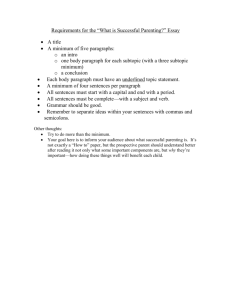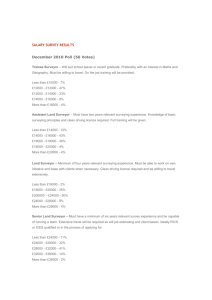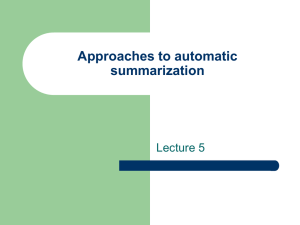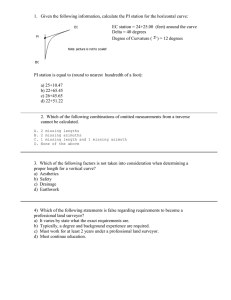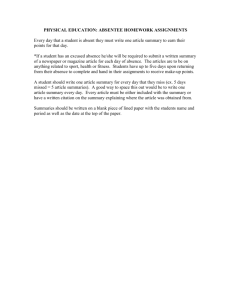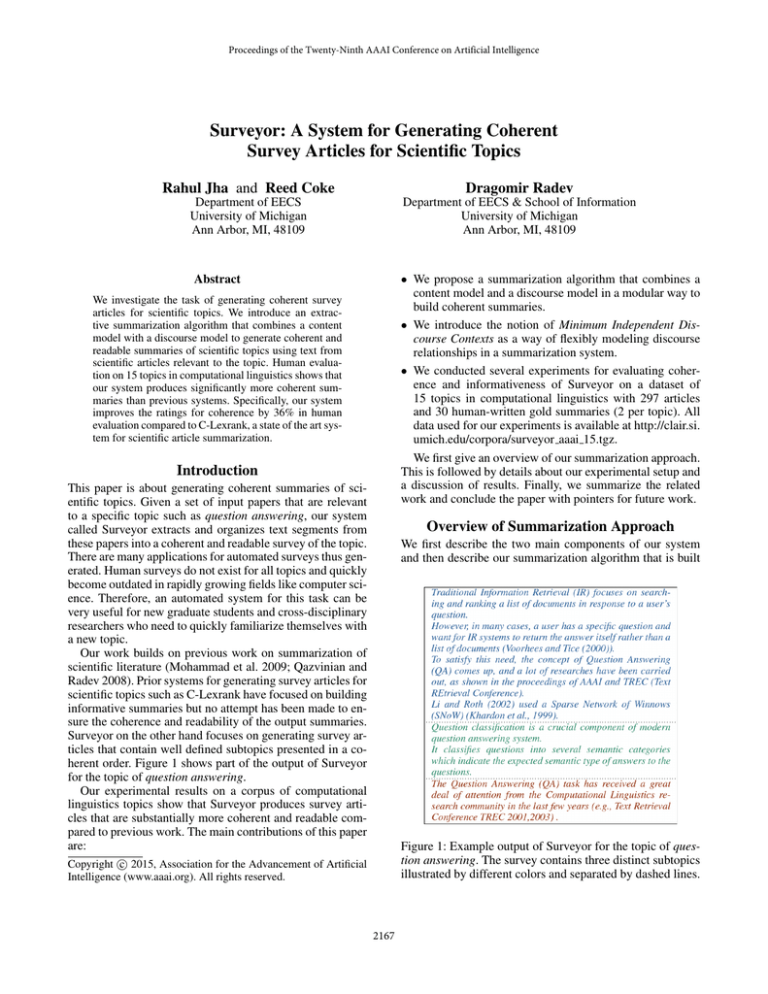
Proceedings of the Twenty-Ninth AAAI Conference on Artificial Intelligence
Surveyor: A System for Generating Coherent
Survey Articles for Scientific Topics
Rahul Jha and Reed Coke
Dragomir Radev
Department of EECS
University of Michigan
Ann Arbor, MI, 48109
Department of EECS & School of Information
University of Michigan
Ann Arbor, MI, 48109
• We propose a summarization algorithm that combines a
content model and a discourse model in a modular way to
build coherent summaries.
• We introduce the notion of Minimum Independent Discourse Contexts as a way of flexibly modeling discourse
relationships in a summarization system.
• We conducted several experiments for evaluating coherence and informativeness of Surveyor on a dataset of
15 topics in computational linguistics with 297 articles
and 30 human-written gold summaries (2 per topic). All
data used for our experiments is available at http://clair.si.
umich.edu/corpora/surveyor aaai 15.tgz.
We first give an overview of our summarization approach.
This is followed by details about our experimental setup and
a discussion of results. Finally, we summarize the related
work and conclude the paper with pointers for future work.
Abstract
We investigate the task of generating coherent survey
articles for scientific topics. We introduce an extractive summarization algorithm that combines a content
model with a discourse model to generate coherent and
readable summaries of scientific topics using text from
scientific articles relevant to the topic. Human evaluation on 15 topics in computational linguistics shows that
our system produces significantly more coherent summaries than previous systems. Specifically, our system
improves the ratings for coherence by 36% in human
evaluation compared to C-Lexrank, a state of the art system for scientific article summarization.
Introduction
This paper is about generating coherent summaries of scientific topics. Given a set of input papers that are relevant
to a specific topic such as question answering, our system
called Surveyor extracts and organizes text segments from
these papers into a coherent and readable survey of the topic.
There are many applications for automated surveys thus generated. Human surveys do not exist for all topics and quickly
become outdated in rapidly growing fields like computer science. Therefore, an automated system for this task can be
very useful for new graduate students and cross-disciplinary
researchers who need to quickly familiarize themselves with
a new topic.
Our work builds on previous work on summarization of
scientific literature (Mohammad et al. 2009; Qazvinian and
Radev 2008). Prior systems for generating survey articles for
scientific topics such as C-Lexrank have focused on building
informative summaries but no attempt has been made to ensure the coherence and readability of the output summaries.
Surveyor on the other hand focuses on generating survey articles that contain well defined subtopics presented in a coherent order. Figure 1 shows part of the output of Surveyor
for the topic of question answering.
Our experimental results on a corpus of computational
linguistics topics show that Surveyor produces survey articles that are substantially more coherent and readable compared to previous work. The main contributions of this paper
are:
Overview of Summarization Approach
We first describe the two main components of our system
and then describe our summarization algorithm that is built
Figure 1: Example output of Surveyor for the topic of question answering. The survey contains three distinct subtopics
illustrated by different colors and separated by dashed lines.
c 2015, Association for the Advancement of Artificial
Copyright Intelligence (www.aaai.org). All rights reserved.
2167
subtopic 1
BB constructs classifiers for English-to-Chinese translation disambiguation by repeating the following two steps: (1) Construct a
classifier for each of the languages on the basis of classified data in both languages, and (2) use the constructed classifier for each
language to classify unclassified data, which are then added to the classified data of the language.
In translation from English to Chinese, for example, BB makes use of unclassified data from both languages.
subtopic 2
Word sense disambiguation (WSD) is the problem of assigning a sense to an ambiguous word, using its context.
The task of Word Sense Disambiguation (WSD) is to identify the correct sense of a word in context.
subtopic 3
We extend previously reported work in a number of different directions: We evaluate the method on all parts of speech (PoS) on
SemCor.
Previous experiments evaluated only nouns on SemCor, or all PoS but only on the Senseval2 and Senseval3 data.
Figure 2: Example sentences from three subtopics learned by the HMM for word sense disambiguation.
on top of them.
start
subtopic 1
subtopic 2
subtopic 3
Content Model Given a set of research papers relevant to
a scientific topic, each of them focusing on a specific aspect of the problem. For example, a paper on supervised
word sense disambiguation might describe the background
on word sense disambiguation followed by a review of supervised methods for the problem. Similarly, a paper on unsupervised word sense disambiguation may give some general overview of the field, then briefly describe supervised
approaches followed by a more detailed overview of unsupervised methods. We capture these subtopics in the input documents and their transitions using a Hidden Markov
Model (HMM) where the states of the HMM correspond to
subtopics. Given the set of k subtopics S = (s1 · · · sk ), the
state transitions of the HMM are defined as:
p(sj |si ) =
subtopic 2
0.50
0.22
0.41
0.25
subtopic 3
0
0
0.02
0.50
Table 1: A partial table of transition probabilities between
three subtopics for word sense disambiguation. The probabilities do not add up to 1 because the table only shows a
few states from a larger transition matrix.
coherent summary, subtopic 2 containing background sentences should appear before subtopic 1 that contains details about a specific method. We use the transition matrix
of the learned HMM to model these subtopic transitions in
the original documents and use it to guide the summarizer
output. As an example, a partial table of transition probabilities learned for the subtopics in Figure 2 is shown in
Table 1, where start is a pseudo-state representing the beginning of the document. The highest outgoing probability
from start is to subtopic 2, which allows the summarizer
to include background information about the topic at the beginning followed by sentences from more specific subtopics
represented by subtopic 1 and subtopic 3.
Count(si , sj ) + δ
Count(si ) + δ ∗ m
Where Count(si , sj ) is the number of times a sentence
from subtopic sj appears immediately after a sentence from
subtopic si in the input document collection and Count(si )
is the total number of times the subtopic si appears in the
input document set. δ is a smoothing parameter and m is the
number of sentences in si .
To initialize the states of the HMM, we use a network
based clustering approach. We build a lexical network where
the sentences represent the nodes of the network and the
edge weights are the tf*idf similarity between each pair of
sentences 1 . Given this lexical network, we use the Louvain
clustering method (De Meo et al. 2011) to partition the lexical network into clusters. Each cluster in the network is then
initialized to a sub-topic. Louvain is a hierarchical clustering
algorithm that does not need the number of output clusters
as a parameter. The HMM is then learned through Viterbi
decoding. Our HMM model is similar to (Barzilay and Lee
2004), but we take the novel step of using the transition matrix to guide the summarization output, as described below.
Figure 2 shows sentences from three of the subtopics
learned for the topic of word sense disambiguation. In a
1
subtopic 1
0.35
0.49
0.24
0.25
Discourse Model A common problem with extractive
summaries is that the sentences used from the original input documents may not be understandable when pulled out
of their original context. To avoid such problems, we introduce the idea of Minimum Independent Discourse Contexts
(MIDC).
Definition. Given a text segment T containing n sentences (s1 · · · sn ), the minimum independent discourse context (midc) of a sentence si is defined as the minimum set
of j sentences midc(si ) = (si−j · · · si ) such that given
midc(si ), si can be interpreted independently of the other
sentences in T .
Figure 3 shows how this idea works in practice. Sentences
s1 and s4 can be included in a summary without requiring
additional context sentences. Sentences s2, s3 and s4 on the
other hand, depend on a set of previous sentences in order
to be understandable. A summary that includes sentence s3,
The idfs are computed over the entire input corpus.
2168
s1
s2
s3
s4
s5
Opinion words are words that convey positive or negative polarities.
They are critical for opinion mining (Pang et al., 2002; Turney, 2002; Hu and
Liu, 2004; Wilson et al., 2004; Popescu and Etzioni, 2005; Gamon et al., 2005;
Ku et al., 2006; Breck et al., 2007; Kobayashi et al., 2007; Ding et al., 2008;
Titov and McDonald, 2008; Pang and Lee, 2008; Lu et al., 2009).
The key difficulty in finding such words is that opinions expressed by many of
them are domain or context dependent.
Several researchers have studied the problem of finding opinion words (Liu,
2010).
The approaches can be grouped into corpus-based approaches
(Hatzivassiloglou and McKeown, 1997; Wiebe, 2000; Kanayama and
Nasukawa, 2006; Qiu et al., 2009) and dictionary-based approaches (Hu and
Liu 2004; Kim and Hovy, 2004; Kamps et al., 2004; Esuli and Sebastiani,
2005; Takamura et al., 2005; Andreevskaia and Bergler, 2006; Dragut et al.,
2010).
midc(s1)
midc(s2)
midc(s3)
midc(s4)
midc(s5)
=
=
=
=
=
∅
{s1}
{s1, s2}
∅
{s4}
Figure 3: A paragraph from an input paper on the topic of opinion mining along with the midc for each sentence on the right.
Discourse relationship
Coreference
Discourse Transition
Entity Transition
Dependency rule
Add a dependency between si
and sj if they belong to a
coreference chain.
Add a dependency between
si−1 and si if si contains an
explicit discourse marker.
Add a dependency between si
and sj if they both share a
prominent entity.
subtopics and their transition matrix by running HMM on
the input document set. After initializing the first subtopic
to the pseudo-subtopic start, it iteratively picks the next
subtopic by using the HMM transition matrix. Given each
subtopic, it runs a salience algorithm on all the sentences of
the subtopic to find the most central sentence of the subtopic.
In the current implementation, this is done using Lexrank
(Erkan and Radev 2004). Given the subtopic’s most central
sentence, it calculates the midc for this sentence and if the
midc is valid, it is added to the output summary. An midc
can be invalid if it exceeds a maximum threshold number of
sentences 2 The midc is then removed from the subtopic so
it will not be picked if we visit this subtopic again. This procedure continues until we obtain a summary of the desired
length. Important subtopics in the input can get more than
one midc in the summary because the transition matrix contains high probabilities for transitioning to these subtopics.
Table 2: Discourse rules used to create minimum independent discourse contexts.
for example, must include sentences s1 and s2 for it to be
understood outside of its original text.
To calculate the midcs for sentences in practice, we use
discourse rules that are triggered by coreference dependencies, explicit discourse dependencies and entity links between sentences. These rules are summarized in Table 2. Every time a discourse rule is triggered, a dependency is added
between two sentences. The midc for a sentence si is all the
sentences preceding si in the input document to which it has
a dependency edge. The coreference chains are found using
the Stanford dependency parser (de Marneffe, MacCartney,
and Manning 2006) and the discourse markers are obtained
from the Penn Discourse TreeBank (Prasad et al. 2008). The
prominent entities used for creating entity links are nouns
that appear in the syntactic role of subject or object in any
sentence in the input.
Treating midcs as the units of content that are combined
to build the extractive summaries allows us to take into
account discourse level dependencies and generate locally
coherent summaries without complicating the optimization
procedure.
input : docs, maxlen
output: summary of length maxlen
summary ← ∅;
transitionMatrix ← HMM(docs);
curSubtopic ← start;
while len(summary) < maxlen do
nextSubtopic ← transitionMatrix.next(curSubtopic);
nextSent ← getMostSalient(sents(nextSubtopic)));
nextMidc ← midc(nextSent);
if valid(nextMidc) then
summary.add(nextMidc);
sents(nextSubtopic).remove(nextMidc)
end
curSubtopic ← nextSubtopic;
end
return summary;
Figure 4: Summarization Algorithm.
Summarization Algorithm We now describe how our
summarization algorithm works given the output of these
two components. The pseudocode for the algorithm is presented in Figure 4.
The algorithm accepts a set of input documents docs and
a maximum summary length maxlen. It first learns the
2
This constraint is added so that a highly salient sentence with
a long midc does not dominate most of the output summary.
2169
Topic
coreference resolution
dependency parsing
grammar induction
information extraction
information retrieval
machine translation
named entity recognition
question answering
semantic role labeling
semi supervised learning
sentiment analysis
speech recognition
summarization
topic modeling
word sense disambiguation
Experimental Setup
The main research questions that we want to answer using
our experiments are:
1. Are the summaries created using Surveyor more coherent
than previous state-of-the-art methods for survey article
generation?
2. What are the individual contributions of the content model
and the discourse model?
3. How does Surveyor compare against state-of-the-art systems for coherent news summarization applied to the survey generation problem?
For research question 1, we compare our system with CLexrank (Mohammad et al. 2009), a state-of-the-art system
for survey generation. For research question 2, we measure
the effects of HMM and MIDC models in isolation on the
quality of output summaries. For research question 3, we
compare our system with G-F LOW (Christensen et al. 2013),
a state-of-the-art system for coherent summarization of news
articles. We now describe the data used in our experiments.
# Sentences
397
487
407
495
560
552
383
452
466
506
613
445
507
412
425
Table 3: List of topics used in our experiments.
Experiments
Coherence Evaluation with C-Lexrank For coherence
evaluation, we generated fixed length 2000 character summaries using both C-Lexrank and Surveyor. Six assessors
with background in computational linguistics manually evaluated pairs of output summaries. Given two summaries, the
assessors were asked to mark which summary they preferred, or mark “indifferent” if they could not choose one
against the other. The presentation of summary pairs to assessors as well as the order of summaries in each pair was
randomized. Thus, the assessors had no way of telling which
systems produced the pair of summaries they saw.
Compared to C-Lexrank, the assessors preferred a summary generated by Surveyor 67% of the time and were indifferent 20% of the time (Table 4).
Data
We used the ACL Anthology Network (AAN) (Radev et al.
2013) as a corpus for our experiments and selected 15 established topics in computational linguistics for our evaluation.
The input documents used for summarization of a research
topic should be research papers that describe the most relevant research in the topic. Since the focus of this paper is
on summarization, we used an oracle method for selecting
the initial set of papers for each topic. We collected at least
three human-written surveys on each topic. The bibliographies of all the surveys were processed using Parscit (Luong,
Nguyen, and Kan 2010) and any document that appeared in
the bibliography of more than one survey was added to the
initial document set Di .
An ideal survey article on the topic should describe the
research represented by Di . These sentences are actually
found in papers that cite papers in Di and thus describe their
contributions. Therefore to create the final document set Df ,
we collect all the papers in AAN that cite the papers in Di . 3
The citing documents are then ordered based on the number
of papers in Di that they cite and the top n documents are
added to Df . The text input for the summarization system
is extracted from Df . For our current experiments, the value
of n is set to 20.
For the task of survey article generation, the most relevant
text is found in the introduction sections of Df since this is
where researchers describe the prior work done by subsets
of papers in Di . Therefore, we extract the sentences in the
introductions of each of the papers in Df as the text input
for our summarizer. Table 3 shows the set of 15 topics and
size of summarizer input for each topic.
Surveyor
67%
Indifferent
20%
C-Lexrank
13%
Table 4: Overall summary preference for Surveyor compared to C-Lexrank.
Additionally, the assessors were asked to rate each summary based on the standard DUC quality questions 4 . The
DUC quality questions are a standard benchmark used for
evaluating summaries on the aspects of overall coherence,
avoiding useless text, avoiding repetitive information, avoiding bad referents and avoiding overly explicit referents. For
each of the questions, the assessors can assign a score from
1 to 5 with higher being better.
As shown in Table 5, the assessors also assigned much
higher scores to summaries generated by Surveyor on an average compared to C-Lexrank on all the DUC quality questions 5 . On the metric of coherence, the scores for Surveyor
4
3
http://duc.nist.gov/duc2004/quality.questions.txt
DUC quality responses represent a Likert-type scale. The use
of parametric statistics such as mean for such data has been debated, but there are several recent arguments for its validity (Norman 2010).
On average, we found only 33% of the documents in Di to be
in AAN. Since the citation network for AAN contains only citations within AAN documents, we implemented a record matching
algorithm to find all the papers in AAN that cite any arbitrary document outside AAN.
5
2170
Quality Question
coherence
avoid useless text
avoid repetition
avoid bad referents
avoid overly explicit referents
C-Lexrank
2.72 ± 0.16
3.20 ± 0.15
4.07 ± 0.11
3.43 ± 0.16
4.23 ± 0.12
Surveyor
3.70 ± 0.22
3.90 ± 0.15
4.23 ± 0.14
4.17 ± 0.14
4.47 ± 0.11
Surveyor HMM Only
2.57 ± 0.20
3.17 ± 0.19
3.97 ± 0.19
3.60 ± 0.18
4.30 ± 0.19
Surveyor MIDC Only
3.07 ± 0.36
3.33 ± 0.30
4.40 ± 0.19
3.47 ± 0.27
4.53 ± 0.22
Table 5: Average scores on the DUC quality questions for C-Lexrank and different Surveyor variants along with standard error.
compared to C-Lexrank were higher by 36%. Both on the
metrics of avoiding useless text and avoiding bad referents,
the scores for Surveyor were higher by about 22%.
standard evaluation metric for automatic evaluation of summaries that uses n-gram co-occurrences between automated
summaries and human generated reference summaries to
score the automated summaries. ROUGE has been shown
to correlate well with human evaluations (Lin 2004a).
For ROUGE evaluation, we asked two assessors to generate 2000 character long gold summaries using the input for each topic. We then did ROUGE evaluation of
the summaries generated using C-Lexrank and Surveyor
against these gold summaries. The average ROUGE-1 and
ROUGE-2 scores are summarized below in Table 7. The improvement in ROUGE scores of Surveyor over C-Lexrank
is statistically significant with p < 0.05. Thus Surveyor, in
addition to producing more coherent summaries, also produces summaries that are more informative given the same
input text.
Contribution of Individual Components To compare the
contribution of the content model and the discourse model,
we created two additional variants of our system. Surveyor
HMM Only contains only the HMM component, but does
not use the discourse component that adds the midcs for the
output sentences. Surveyor MIDC only uses the discourse
component, but instead of relying on the HMM transition
matrix to generate the subtopic flow, chooses the subtopics
based on their size, where size of a subtopic is the number of
sentences assigned to the subtopic. It starts from the largest
subtopic and goes through subtopics in order of their size.
We asked our assessors to compare summaries output by
each system with the output of C-Lexrank as well rate summaries produced by each system on the DUC quality questions. The results of the direct comparison is summarized in
Table 6 and the average DUC ratings are reported in Table 5.
Surveyor HMM Only
53%
Surveyor MIDC Only
33%
Indifferent
27%
Indifferent
27%
System
C-Lexrank
Surveyor
Surveyor HMM Only
Surveyor MIDC only
C-Lexrank
20%
C-Lexrank
40%
ROUGE-1
0.40
0.44
0.42
0.42
ROUGE-2
0.05
0.19
0.13
0.13
Table 7: Average Rouge scores for each of the systems for 15
topics evaluated against two reference summaries per topic.
Even with just the HMM content model, the summaries
from Surveyor HMM Only are preferred by assessors compared to C-Lexrank. Surveyor MIDC Only does not do as
well in direct comparison, which suggests that without a coherent flow of subtopics, the addition of midcs to the output
sentences does not improve the perceived overall quality of
a summary. This shows the importance of the HMM content model and suggests that a summary that jumps between
subtopics in an incoherent way will not be perceived as coherent even if the individual sentences in the summary have
appropriate context. However, the scores for both of these
systems on the DUC quality questions (Table 5) show that
the addition of midcs does affect the assessors’ judgement of
specific summary qualities and is an important component of
the system. This explains why the combination of both the
content model and the discourse model leads to much better
results than either of them in isolation (Tables 4 and 6).
Previous evaluations for survey generation systems use
citing sentences as input as opposed to sentences from the
main text. There is no standard summarization evaluation
that allows us to evaluate the informativeness of summaries
generated using two different input sources. To compare
summaries created using citing sentences and source sentences in terms of coherence, we ran C-Lexrank using both
citing sentences and introduction sentences as summarizer
input and did a coherence evaluation with our assessors. The
assessors preferred summaries generated by using introductions as source 60% of the time while preferring summaries
generated by using citing sentences as source only 27% of
the time. Even though a direct comparison of informativeness is not possible, we posit that since our summaries include background information as part of the survey, our summaries would have to be slightly longer than those based on
citing sentences in order to be as informative. However, results from coherence evaluation show that using source sentences allows us to use topical and discourse information in
the original papers to generate much more coherent summaries compared to citing sentences.
Informativeness Evaluation We use ROUGE (Lin
2004b) for informativeness evaluation. ROUGE is a
Evaluation with G-F LOW G-F LOW (Christensen et al.
2013) is a recent state of the art system for generating co-
Table 6: Overall summary preference for the two Surveyor
variants compared to C-Lexrank.
2171
herent summaries that has been evaluated on newswire data.
We compared Surveyor with G-F LOW by running the implementation of G-F LOW obtained from the original authors on our evaluation data. The coherence evaluation with
G-F LOW was done in the same way as for C-Lexrank except
the output summary length for both systems was limited to
1000 characters. This is because the optimization procedure
implemented in G-F LOW becomes intractable for output of
2000 characters 6 .
In the coherence evaluation, assessors preferred Surveyor 47% of the time compared to 40% of the time for
G-F LOW (Table 8).
Surveyor
47%
Indifferent
13%
resulting summaries. In the medical domain, several summarization systems have been proposed that take advantage
of the rich ontological data available for medical concepts
(Elhadad and McKeown 2001; Kan, McKeown, and Klavans 2001; Yoo, Hu, and Song 2006). A different stream
of research has looked at summarizing scientific research
using the metaphor of maps (Fried and Kobourov 2013;
Shahaf, Guestrin, and Horvitz 2012). For the work on single
document summarization for scientific literature, we refer
the readers to the review in Nenkova and McKeown (2011).
Ordering the sentences in summarization output for improving readability has been studied by Barzilay and McKeown (2005) and Bollegala, Okazaki, and Ishizuka (2010).
Automatic metrics for estimating coherence for summarization evaluation have also been studied (Lapata 2005;
Lin et al. 2012). More recently, Christensen et al. (2013)
presented an algorithm called G-F LOW for joint sentence
selection and ordering for news summarization.
Barzilay and Lee (2004) and Fung and Ngai (2006) have
presented HMM based content models that use the HMM
topics as features in a supervised summarization system to
produce informative summaries. LDA (Latent Dirichlet Allocation) based content models for summarizing documents
(Daumé and Marcu 2006; Haghighi and Vanderwende 2009)
have also been explored, but they focus on maximizing informativeness instead of coherence.
G-F LOW
40%
Table 8: Overall summary preference for Surveyor compared to G-F LOW.
Surveyor also obtains higher scores than G-F LOW on the
DUC quality questions (Table 9). The scores for Surveyor
and G-F LOW are summarized below separately because of
the difference in the output length compared to the previous
evaluation. The numbers are reported with standard error.
Quality Question
coherence
avoid useless text
avoid repetition
avoid bad referents
avoid overly explicit referents
Surveyor
3.53 ± 0.36
3.60 ± 0.36
4.93 ± 0.07
3.93 ± 0.33
4.73 ± 0.12
G-F LOW
3.40 ± 0.25
3.47 ± 0.17
4.53 ± 0.19
3.80 ± 0.22
4.47 ± 0.19
Conclusion and Future Work
In this paper, we present Surveyor, a system for generating
coherent surveys of scientific articles. We describe our algorithm and present experimental results on a corpus of 15
topics in computational linguistics. Our results show that our
system leads to more coherent summaries than C-Lexrank,
a state-of-the-art system for survey article generation and
G-F LOW, a state-of-the-art system for coherent summarization. In particular, in human evaluation for coherence, Surveyor outperforms the performance of C-Lexrank by 36%
and outperforms the performance of G-F LOW by 4%.
This work suggests several possible future directions for
research. The first is developing more sophisticated content
models that better capture the distribution of topics in scientific documents across genres. The second is building a
corpus of discourse relationships between sentences in scientific documents as well as improving the algorithm for creating minimum independent discourse context. Finally, automatic sentence compression, fusion and rewriting strategies can be applied to sentences of the output summary to
remove irrelevant text segments and improve the informativeness of the summaries.
Table 9: Average scores on the DUC quality questions for
Surveyor compared with G-F LOW.
In informativeness evaluation with ROUGE, the 1000
character summaries generated by Surveyor got an average ROUGE-1 score of 0.41 compared to a score of 0.36
obtained by G-F LOW. The ROUGE-2 score of Surveyor
was 0.13 compared to 0.07 for G-F LOW. p-values for the
ROUGE-1 and ROUGE-2 improvements of Surveyor over
G-F LOW are 0.12 and 0.11 respectively. These results indicate that Surveyor does slightly better than G-F LOW in
terms of coherence evaluation while also producing informative summaries. This suggests that the HMM based
content model does a better job of modeling the flow of
subtopics in scientific articles compared to G-F LOW which
does not include such a component.
Related Work
Multi-document summarization of scientific articles has
been studied by Nanba, Kando, and Okumura (2004). Mohammad et al. (2009) compared several algorithms for generating automated surveys of scientific topics. Jha, AbuJbara, and Radev (2013) implemented a system that can
summarize a topic starting from a query as input. However,
none of these papers focused on evaluating the coherence of
6
Acknowledgments
We thank the anonymous reviewers for their feedback on
earlier versions of this paper. Also, thanks to Janara Christensen for providing results of running G-F LOW on our
data. Finally, thanks to Inderjeet Mani, Zornitsa Kozareva,
Or Biran, Ben King, Veronica Perez Rosas, Charlie Welch,
Shibamouli Lahiri, Max Kaufmann and Shiwali Mohan for
several useful discussions and help with evaluations.
Personal communication with Christensen et al.
2172
References
mation retrieval. In Proc. of the Document Understanding
Conference (DUC, 6.
Lapata, M. 2005. Automatic evaluation of text coherence:
models and representations. In In the Intl. Joint Conferences
on Artificial Intelligence, 1085–1090.
Lin, Z.; Liu, C.; Ng, H. T.; and Kan, M.-Y. 2012. Combining
coherence models and machine translation evaluation metrics
for summarization evaluation. In Proceedings of the 50th Annual Meeting of the Association for Computational Linguistics: Long Papers - Volume 1, ACL ’12, 1006–1014. Stroudsburg, PA, USA: Association for Computational Linguistics.
Lin, C. Y. 2004a. Looking for a few good metrics: Automatic
summarization evaluation - how many samples are enough? In
Proceedings of the NTCIR Workshop 4.
Lin, C.-Y. 2004b. ROUGE: A package for automatic evaluation of summaries. In Proceedings of the ACL workshop on
Text Summarization Branches Out.
Luong, M.-t.; Nguyen, T. D.; and Kan, M.-y. 2010. Logical
Structure Recovery in Scholarly Articles with Rich Document
Features. IJDLS.
Mohammad, S.; Dorr, B.; Egan, M.; Hassan, A.; Muthukrishan, P.; Qazvinian, V.; Radev, D.; and Zajic, D. 2009. Using citations to generate surveys of scientific paradigms. In
Proceedings of Human Language Technologies: The 2009 Annual Conference of the North American Chapter of the Association for Computational Linguistics, NAACL ’09, 584–592.
Stroudsburg, PA, USA: Association for Computational Linguistics.
Nanba, H.; Kando, N.; and Okumura, M. 2004. Classification
of research papers using citation links and citation types: Towards automatic review article generation. In Proceedings of
the 11th SIG Classification Research Workshop, 117–134.
Nenkova, A., and McKeown, K. 2011. Automatic summarization. Foundations and Trends in Information Retrieval 5(23):103–233.
Norman, G. 2010. Likert scales, levels of measurement and
the laws of statistics. Advances in Health Sciences Education
15(5):625–632.
Prasad, R.; Dinesh, N.; Lee, A.; Miltsakaki, E.; Robaldo, L.;
Joshi, A.; and Webber, B. 2008. The penn discourse treebank
2.0. In In Proceedings of LREC.
Qazvinian, V., and Radev, D. R. 2008. Scientific paper summarization using citation summary networks. In COLING
2008.
Radev, D. R.; Muthukrishnan, P.; Qazvinian, V.; and AbuJbara, A. 2013. The acl anthology network corpus. Language
Resources and Evaluation 1–26.
Shahaf, D.; Guestrin, C.; and Horvitz, E. 2012. Metro maps
of science. In Proceedings of the 18th ACM SIGKDD International Conference on Knowledge Discovery and Data Mining,
KDD ’12, 1122–1130. New York, NY, USA: ACM.
Yoo, I.; Hu, X.; and Song, I.-Y. 2006. A coherent biomedical literature clustering and summarization approach through
ontology-enriched graphical representations. In Tjoa, A., and
Trujillo, J., eds., Data Warehousing and Knowledge Discovery, volume 4081 of Lecture Notes in Computer Science.
Springer Berlin Heidelberg. 374–383.
Barzilay, R., and Lee, L. 2004. Catching the drift: Probabilistic content models, with applications to generation and
summarization. In Susan Dumais, D. M., and Roukos, S.,
eds., HLT-NAACL 2004: Main Proceedings, 113–120. Boston,
Massachusetts, USA: Association for Computational Linguistics.
Barzilay, R., and McKeown, K. R. 2005. Sentence fusion for
multidocument news summarization. Computational Linguistics 31(3):297–328.
Bollegala, D.; Okazaki, N.; and Ishizuka, M. 2010. A bottomup approach to sentence ordering for multi-document summarization. Information Processing & Management 46(1):89 –
109.
Christensen, J.; Mausam; Soderland, S.; and Etzioni, O. 2013.
Towards coherent multi-document summarization. In Proceedings of the North American Chapter of the Association
for Computational Linguistics: Human Language Technologies (NAACL 2013).
Daumé, III, H., and Marcu, D. 2006. Bayesian query-focused
summarization. In Proceedings of the 21st International Conference on Computational Linguistics and the 44th Annual
Meeting of the Association for Computational Linguistics,
ACL-44, 305–312. Stroudsburg, PA, USA: Association for
Computational Linguistics.
de Marneffe, M.-C.; MacCartney, B.; and Manning, C. D.
2006. Generating typed dependency parses from phrase structure parses. In The International Conference on Language
Resources and Evaluation (LREC), volume 6, 449–454. Citeseer.
De Meo, P.; Ferrara, E.; Fiumara, G.; and Provetti, A. 2011.
Generalized louvain method for community detection in large
networks. CoRR abs/1108.1502.
Elhadad, N., and McKeown, K. R. 2001. Towards generating
patient specific summaries of medical articles. In In Proceedings of NAACL-2001 Automatic Summarization Workshop.
Erkan, G., and Radev, D. R. 2004. Lexrank: Graph-based centrality as salience in text summarization. Journal of Artificial
Intelligence Research (JAIR).
Fried, D., and Kobourov, S. G. 2013. Maps of Computer
Science. ArXiv e-prints.
Fung, P., and Ngai, G. 2006. One story, one flow: Hidden
markov story models for multilingual multidocument summarization. ACM Trans. Speech Lang. Process. 3(2):1–16.
Haghighi, A., and Vanderwende, L. 2009. Exploring content
models for multi-document summarization. In Proceedings of
Human Language Technologies: The 2009 Annual Conference
of the North American Chapter of the Association for Computational Linguistics, NAACL ’09, 362–370. Stroudsburg, PA,
USA: Association for Computational Linguistics.
Jha, R.; Abu-Jbara, A.; and Radev, D. R. 2013. A system
for summarizing scientific topics starting from keywords. In
Proceedings of The Association for Computational Linguistics
(short paper).
Kan, M.; McKeown, K. R.; and Klavans, J. L. 2001. Domainspecific informative and indicative summarization for infor-
2173

